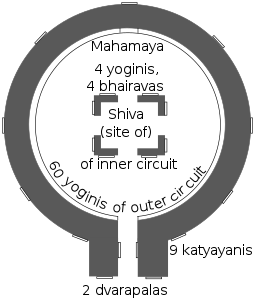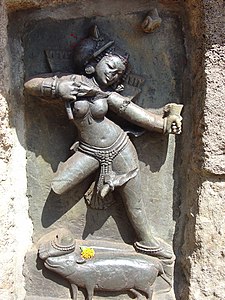Hindu temple in Odisha, India
| Chausath Yogini Temple | |
|---|---|
| Chausath Yogini Mandir | |
 | |
| Religion | |
| Affiliation | Hinduism |
| District | Khurda |
| Deity | Kali |
| Festivals | Kali Puja |
| Location | |
| Location | Hirapur |
| State | Odisha |
| Country | |
 | |
| Geographic coordinates | 20°13′35.454″N 85°52′32.141″E / 20.22651500°N 85.87559472°E / 20.22651500; 85.87559472 |
| Architecture | |
| Type | Hypaethral |
| Specifications | |
| Temple(s) | 2 |
| Monument(s) | 3 |
| Elevation | 17 m (56 ft) |
The Chausath Yogini Temple (64-Yogini Temple) of Hirapur, also said Mahamaya Temple, is 20 km outside Bhubaneswar, the capital of Odisha state of Eastern India. It devotes to the worship of the yoginis, auspicious goddess-like figures.
Religious aspect
Hirapur's yogini temple is a tantric shrine, with hypaethral (roofless) architecture as tantric prayer rituals involve worshipping the bhumandala (environment consisting all the 5 elements of nature - fire, water, earth, air and ether), and the yoginis believe to be capable of flight.
The yogini idols represent female figures standing on an animal, a demon or a human head depicting the victory of Shakti (Eternal power). According to Hindu mythology, aadishakti is the eternal power which came into existence on its own and then created everything by its will. Aadishakti (recognized as the goddess because of its motheristic character) is the supreme power. The idols express everything from rage, sadness, pleasure, joy, desire and happiness. The number 64 finds its reference in Hindu mythology in forms such as Kālá for time, Kalā for performing arts etc.
Such temples dedicate to yoginis, although rare, are also seen at Ranipur-Jharial site of the Balangir district in Odisha and seven other places in India.
History
The temple is believed to have been built by the Bhouma dynasty queen of Lonabhadra alias Santikaradeva II, Hiradevi during 864 CE. It is the first Chausath Yogini Temple of India.
The legend behind the temple, according to local priests, is that the Goddess Durga took the form of 64 demi-goddesses to defeat a demon. After the fight the 64 goddesses, equated with yoginis, asked Durga to commemorate them in the form of a temple structure.
The temple complex is now maintained by Archaeological Survey of India.
Kalapahad, a Muslim convert general of the 16th century CE, is said to have attacked this temple and broken the murtis. He is also known as the destroyer of Jaganath and Konark temples.
Architecture
The temple is small and circular, only 25 feet in diameter. It is hypaethral, and built of blocks of sandstone. The inside of the circular wall has niches, each housing the statue of a Goddess. 56 of the 64 idols, made of black stone, survive. They surround the main image at the centre of the temple, the Goddess Kali, who stands on a human head, representing the triumph of the heart over the mind. Some historians believe that an idol of Maha Bhairava was worshipped in the Chandi Mandapa. The temple seems to follow a mandala plan in a way that concentric circles are formed while a Shiva at the center inside the inner sanctum is roundly surrounded by four Yoginis and four Bhairavas.
The circle is reached via a protruding entrance passage, so that the plan of the temple has the form of a yoni-pedestal for a Shiva lingam.
The Yogini images depict standing goddesses and their animal vehicles (vahana). The Yoginis are naked but for their bejewelled girdles, from which hang flimsy skirts that can be made out as a light decoration on their legs; they are adorned with bracelets, armlets, necklaces, and anklets.
The scholar István Keul writes that the yogini images are of dark chlorite rock, about 40 cm tall, and standing in varying poses on plinths or vahanas, their animal vehicles; most have "delicate features and sensual bodies with slender waists, broad hips, and high, round breasts" with varying hairstyles and body ornaments.
-
Yogini images in simple niches
-
One of the Yoginis
-
 Plan; scholars have noted the resemblance to a yoni-pedestal
Plan; scholars have noted the resemblance to a yoni-pedestal
-
 A yogini with an offering of flowers at her feet
A yogini with an offering of flowers at her feet
-
Part of the circle of Yoginis
-
 One legged Ekapada-Bhairava
One legged Ekapada-Bhairava
See also
- Chausath Yogini Temple, Bhedaghat
- Chausath Yogini Temple, Ranipur Jharial
- Chausath Yogini Temple, Mitaoli
- Chausath Yogini Temple, Khajuraho
References
- "Orissa Review, Government Gazette". Orissa Review. 43. Home Department, Government of Orissa: 30. 1986.
- ^ "Chausathi Yogini Temple – A Place of Wondrous Occult - Sand Pebbles Tour N Travels". Sand Pebbles Tour N Travels. 15 June 2014. Archived from the original on 20 December 2016. Retrieved 6 December 2016.
- "Yogini temple of Hirapur". The Hindu. 17 October 2003.
- ^ Saravanan, V. Hari (2014). Gods, Heroes and their Story Tellers: Intangible cultural heritage of South India. Notion Press. ISBN 978-9384391492.
- "Chausath Yogini Temple Hirapur – A 9TH CE GEM OF ODISHA". Anuradha Goyal. February 2020.
- Dehejia 1986, p. 10.
- Hatley 2007, p. 113.
- ^ Keul 2012, pp. 367–369.
- Hatley 2007, p. 112.
Bibliography
- Das, Adyasha (2019). The Chausathi Yoginis of Hirapur: From Tantra to Tourism. Black Eagle. ISBN 978-1-64560-012-1.
- Dehejia, Vidya (1986). Yogini Cult and Temples: A Tantric Tradition. National Museum, Janpath, New Delhi.
- Hatley, Shaman (2007). The Brahmayāmalatantra and Early Śaiva Cult of Yoginīs. University of Pennsylvania (PhD Thesis, UMI Number: 3292099). pp. 1–459.
- Keul, István (2012). "Blending into the Religious Landscape: The Yoginīs in Benares". Numen. 59 (4). Brill: 366–402. doi:10.1163/156852712x641796. ISSN 0029-5973. JSTOR 23244944.
External links
 Media related to Chausath Yogini Temple, Hirapur at Wikimedia Commons
Media related to Chausath Yogini Temple, Hirapur at Wikimedia Commons- Detail Study
| Khordha district | |
|---|---|
| Constituencies | |
| Towns and villages | |
| Other districts | |
| Yoginis | ||
|---|---|---|
| Entities | ||
| Yogini temples | ||
| Related | ||
| Yoginis | ||
|---|---|---|
| Entities | ||
| Yogini temples | ||
| Related | ||
- 9th-century Hindu temples
- Hindu temples in Bhubaneswar
- Archaeological monuments in Odisha
- Sandstone buildings in India
- Hindu temples in Khordha district
- Kali temples
- Tourist attractions in Bhubaneswar
- Shaktism
- Yogini temples
- Hindu temples sacked in the Muslim period in the Indian subcontinent
- Hindu temples in Odisha
- Balangir district
